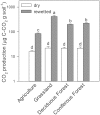Resuscitation of the rare biosphere contributes to pulses of ecosystem activity
- PMID: 25688238
- PMCID: PMC4311709
- DOI: 10.3389/fmicb.2015.00024
Resuscitation of the rare biosphere contributes to pulses of ecosystem activity
Abstract
Dormancy is a life history trait that may have important implications for linking microbial communities to the functioning of natural and managed ecosystems. Rapid changes in environmental cues may resuscitate dormant bacteria and create pulses of ecosystem activity. In this study, we used heavy-water (H(18) 2O) stable isotope probing (SIP) to identify fast-growing bacteria that were associated with pulses of trace gasses (CO2, CH4, and N2O) from different ecosystems [agricultural site, grassland, deciduous forest, and coniferous forest (CF)] following a soil-rewetting event. Irrespective of ecosystem type, a large fraction (69-74%) of the bacteria that responded to rewetting were below detection limits in the dry soils. Based on the recovery of sequences, in just a few days, hundreds of rare taxa increased in abundance and in some cases became dominant members of the rewetted communities, especially bacteria belonging to the Sphingomonadaceae, Comamonadaceae, and Oxalobacteraceae. Resuscitation led to dynamic shifts in the rank abundance of taxa that caused previously rare bacteria to comprise nearly 60% of the sequences that were recovered in rewetted communities. This rapid turnover of the bacterial community corresponded with a 5-20-fold increase in the net production of CO2 and up to a 150% reduction in the net production of CH4 from rewetted soils. Results from our study demonstrate that the rare biosphere may account for a large and dynamic fraction of a community that is important for the maintenance of bacterial biodiversity. Moreover, our findings suggest that the resuscitation of rare taxa from seed banks contribute to ecosystem functioning.
Keywords: CO2 pulses; desiccation; dominance; dormancy; rarity; seed bank; soil rewetting; stable isotope probing (SIP).
Figures






References
-
- Aanderud Z. T., Jones S. E., Schoolmaster D. R., Fierer N., Lennon J. T. (2013). Sensitivity of soil respiration and microbial communities to altered snowfall. Soil. Biol. Biochem. 57, 217–227 10.1016/j.soilbio.2012.07.022 - DOI
-
- Aanderud Z. T., Schoolmaster D. R., Lennon J. T. (2011). Plants mediate the sensitivity of soil respiration to rainfall variability. Ecosystems 14, 156–167 10.1007/s10021-010-9401-y - DOI
-
- Alonso-Gutiérrez J., Figueras A., Albaigés J., Jiménez N., Viñas M., Solanas A. M., et al. . (2009). Bacterial communities from shoreline environments (Costa da Morte, Northwestern Spain) affected by the prestige oil spill. Appl. Environ. Microbiol. 75, 3407–3418. 10.1128/AEM.01776-08 - DOI - PMC - PubMed
LinkOut - more resources
Full Text Sources
Other Literature Sources
Miscellaneous

